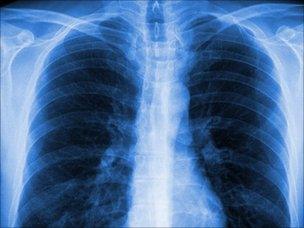Medical notes: Pulmonary embolism
- Published

Drugs can help most people with blood clots on the lungs to recover
A pulmonary embolism or blood clot on the lungs is a serious and potentially life-threatening condition.
However, if treated, most patients will make a full recovery.
What is it?
A pulmonary embolism is a blood clot that has entered the lungs.
Small clots may cause no symptoms at all and medium-sized clots may cause sudden breathlessness.
When the clot is large, it can stop blood from flowing through the lungs. This can cause a person to collapse or even die.
What causes it?
Clots occur when blood passing through the deepest veins flow so slowly that they form a solid clot, also known as deep vein thrombosis (DVT).
The clot can get wedged in the vein but they can also move up into one of the lungs.
Who is at risk?
Blood clots are rare. They affect one or two people in every thousand, mainly older people.
The clot travels up to the lungs in as many as one in three cases.
Blood clots or DVTs occur most often in people who have not been able to exercise normally.
A DVT can also happen after major surgery or a broken leg because patients are unable to move their leg, for instance.
It can be linked to pregnancy and can occur in patients with advanced cancer.
Studies have suggested that women taking the pill are up to four times more likely to suffer a DVT compared to other women.
There is also an increased risk for women on hormone replacement therapy.
There is growing evidence to suggest people may at risk when they travel.
There may be a particular risk with air travel because of the combination of inactivity and dehydration, which makes the blood more sticky.
How it is treated?
A pulmonary embolism is fatal in one in 10 people if it is left untreated.
Doctors generally prescribe a drug called heparin for the first few days after the clot has been diagnosed.
After a few days, the patient is then given another drug called warfarin.
Both of these drugs thin the blood allowing it to flow more easily around the body and dissolve the clot.
When taking these blood thinning drugs patients usually have regular blood tests to make sure they are getting the right dose and are not at risk of further clots or bleeding.
The prognosis for patients is generally good. The body has a very efficient system for dissolving clots.
The great majority of people make a complete recovery even with a large blood clot on the lungs.
This page contains basic information. If you are concerned about your health, you should consult a doctor.